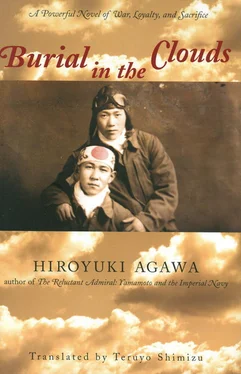During flight training today, news poured in. Carrier-based planes raided the Kanto area, and Yokohama and Kono-ike Air Stations are both presently under attack. Ten land-based attack bombers were sent up at Kono-ike. The capital appears to be suffering blow after blow. Chichi-jima and Iwo-jima also suffered raids.
About twenty Type-96s advanced to this base from Toyohashi. Having mobilized some fifty land-based attack bombers, and an equal number of Gingas, Usa is set to become the largest single rendezvous point for special attack force aircraft. Still, the Ohka Units will not go out just yet. Obviously, they intend to draw the enemy in closer. In the early evening, eighteen Gingas took off, headed for Kanoya in Kagoshima Prefecture.
Some of us are to receive accelerated training, myself included. I thought a full year would pass before I died, but it looks now as if it will be a matter of months.
Got up at five and prepared to meet the enemy planes. The 501st Air Unit has been on standby since midnight. The motors were kept running all through the night. I felt the roar of the propellers in my gut. Ifl don’t brace for it, eyes wide open, I get nauseated. At ground level, the air is heavy and the resistance is stiff, and if you rev up the engines too much you overwork the pistons, which eventually cease to fire normally. Making a racket—pow! pow! pow!—they actually inhibit the spin of the propellers. The maximum limit at ground level is a zero millimeter boost. Zero out the lever and your eardrums all but burst.
At around noon, the crews assembled outside the field headquarters. The order to launch was issued at the report that the enemy had been sighted offshore at Cape Muroto and also at Ariake Bay. Our men will rally at Kanoya Air Station, and, a few hours later, proceed on their special attack missions. We exchanged farewell cups of water, and lined up at an angle along the airstrip to see the planes off, waving our caps. Eighteen Gingas bore the men away. Some waved their caps from the cockpit, others gave salutes. Those who took the trouble to taxi toward us before gliding on to the takeoff point, or who stood up in the front reconnoiterers’ seat, all appeared to be our predecessors from the 13th Class, men from Keio, Waseda, and Tokyo Universities. As they left the ground, the men thrust the tips of their hands from the signalman’s seat and waved to us, vigorously. The hands grew smaller and smaller as the planes gathered speed and quickly slipped out of sight. A tightness gripped my throat. Afterwards, we dispersed the remaining aircraft.
Turned out to be a disappointment. Four days have passed. Nothing happened.
On the 19th, we watched as the Gingas returned. We did hear reports that our side sank two enemy aircraft carriers, and also some battleships and cruisers, but I have to say these successes are insignificant. We never employed our main force after all. If we lay onto a mere handful of aircraft the responsibility of determining the nation’s fate, as if in an effort to put them to their best and highest use, then inevitably our strategy will be a passive one.
The enemy took a full swing before turning back. After receiving reports that their task force was moving, we have heard nothing at all. Ten thousand hostile men landed on Iwo-jima. Should the airfields on this island fall into American hands, Tokyo and Osaka will be within range of whole fleets of enemy fighters and bombers.
Last night’s snow piled up nearly ten centimeters high, but it’s the wet kind. The sun is strong and the air is warm. It’s a fair spring day, and I want to strip down a bit and bask in it. The season has arrived when (as a Manyo poet has it) “the brackens / By the waterfall / Burst into leaf.” G. says that the dandelions may be out. The larks are already singing. Kyushu isn’t half bad, I said to myself, and it’s not bad to be alive, either.
We had a snowball fight. This snow sure packs hard. We wrestled each other, of energy, and made a big snowman. Afterwards we dug up some fresh snow to eat with coffee syrup. Delicious.
Last night, the Ginga men went on a bender, guzzling that rationed sake called “Taiheiyo” (“The Pacific Ocean”). As they wound down, they flocked together and wept. This afternoon, one by one, they departed for Izumi, kicking up snow as they rose from the airstrip. We saw them off.
For the first time in ages, I got a letter from my aunt in Kobe. Brandishing the envelope, which bore her name, Hatsuko Miyoshi, in ink, the instructor demanded fifty sen. (We get fined every time we receive a letter from a woman.) “No,” I protested. “It’s from my aunt. She’s fifty-eight years old. I just contributed five yen the other day, when I hung my plane up on a pothole. Come on, just give me a break, will you?” He didn’t. I had to pay. My aunt says some one hundred B-29s raided Kobe on the 4th of this month, inflicting heavy damage. The Miyoshi residence, however, was safe.
Fujikura is dead.
It happened during training this morning. After I landed, Fujikura climbed into plane #6 for its third flight. Right after takeoff, though, he lifted the nose too high, sending the plane into a stall, and in a flash he had crashed, left wing first. I ran out to the spot. The control stick was embedded in his face, his eyeballs dangled down around his lips, and the back of his head, all whitish, was split open. He was dead, without much bleeding. The impact threw the engine ten meters away from the fuselage. The main left wing had been sheared away by the rocks, and the tail was shattered. At around 1027 on the morning of March 1, Showa 20, Fujikura ended his twenty-five years of life. Senior Aviation Petty Officer B., also on board, was rushed off to the medical ward on a rescue unit stretcher. His face was swollen to twice its normal size, and he suffered deep gashes, but it looks like he will survive. Murase and I stayed behind to tend to Fujikura’s body, while everybody else resumed their flights in the afternoon. Sakai stopped by later. After dinner, we held a wake for Fujikura in the lounge.
The winds blew in from the east today, bringing spring with them. We all took off our uniforms and changed into light and airy fatigues. Fujikura had been wearing a snow-white, open-neck shirt at morning assembly, and the image of it remains in my mind. I try not to let my feelings overcome me, but tears fill my eyes as scattered reminiscences of Fujikura flood my mind: The man who smuggled oranges in his gaiters and shared them with us on a day when we were allowed visitors but no food or drink back at Otake Naval Barracks. The man who, during our farewell party at the Fukais’ house, sang, with a straight face, a song titled “Draw the Lamp and Catch the Lice,” all the while gazing up at the ceiling. The man who so sternly rebuked me for having struck a petty officer by the swimming pool. The man who taught me the difference between a blue flag iris and a rabbit-ear iris at Kutai Temple during the Manyo trip we made in the spring of Showa 18 (after which we engaged in a day-long debate as to whether asthmaweed and horseweed are actually the same).
I don’t know how to handle the notices to his family, to Professors O. and E., and to the Fukais. In the meantime, I at least have to notify Kashima in Kawatana.
He had to die sooner or later, and in his case it’s not quite right to say he must regret having fallen before ever realizing his wish to go to the front. We had few opportunities during the last month or two to sit down and talk, even when we made an outing. As a matter of fact, Fujikura rather seemed to want to avoid talking, and it appeared that something had been troubling him. My guess is that he just couldn’t reconcile himself to the idea of embarking on a special attack mission, and that he agonized, unable to distract himself from it all, day after day. If that’s the case, I really should consider this accident a blessing in disguise, as an unlooked-for death took him before he ever had to face the real anguish.
Читать дальше












